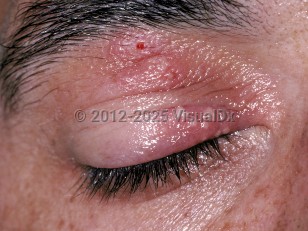The spectrum of ocular herpetic disease also includes conjunctivitis, iritis, and keratitis. Epithelial keratitis involves only the superficial layer of the cornea and is usually caused by active virus replication, while stromal keratitis involves deeper layers of the cornea affected by immunologic responses. Both can lead to corneal scarring and vision loss.
Primary ocular HSV infections occur most often in children. They are usually unilateral, mild infections that often go unrecognized, although they may present as blepharitis or blepharoconjunctivitis. Most symptomatic attacks are recurrences, more commonly presenting as a keratitis, although there have been several reports of recurrent HSV blepharitis.
The treatment of HSV blepharitis is supportive as most cases are self-limiting and resolve within 2-3 weeks. Corneal involvement with HSV, discussed elsewhere, necessitates treatment with antiviral agents to prevent complications.
HSV blepharitis can be differentiated from preseptal or orbital cellulitis on the basis of vesicles and ulcerations.
Immunocompromised Patient Considerations:
- Human immunodeficiency virus (HIV) patients have a higher rate of incidence and recurrence of HSV ocular disease (mainly reported for keratitis) and may take longer to heal, but the ocular manifestations of the disease are not notably more severe.
- Generally speaking, in the immunocompromised patient, HSV infections can present the same as in the immunocompetent patient or manifest with thick hemorrhagic crusts, eschars, persistent large erosions, or ulcers. Widespread dissemination to skin and internal organs, including lungs and liver, may occur (see disseminated HSV). In patients with HIV / AIDS, HSV infections can be severe and chronic.



 Patient Information for
Patient Information for 
